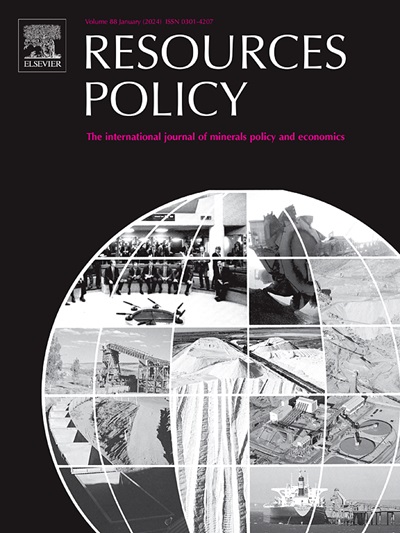Economic viability and risk management of auger mining in Indonesia using real option valuation under volatile market conditions
IF 10.2
2区 经济学
0 ENVIRONMENTAL STUDIES
引用次数: 0
Abstract
Coal is one of the commodities that contribute the most to Indonesia's GDP, as well as to other coal-exporting countries such as Australia, China, India, and others. Currently, many coal companies in Indonesia face challenges in optimizing their coal reserves to increase profitability. One method that has proven effective from both technical and economic perspectives is auger mining. However, with global coal prices declining in 2023 after experiencing a significant increase following the pandemic in 2022 (Iea, 2023), the economic feasibility of auger mining for companies, particularly in the long term, has come into question. This research is the first study aimed at assessing the economic feasibility of auger mining using DCF simulation, Monte Carlo Simulation (MCS), and Real Option Valuation (ROV) Binomial Lattice, based on a real-case problem under uncertain coal market conditions, and evaluating the risks of its implementation.
This study aims to assess the feasibility of auger mining based on three scenarios: Auger Type A (higher productivity with higher mobilization cost) under Standard and Aggressive Utilization, and Auger Type B (lower productivity with lower mobilization cost) under Standard Utilization. Based on the analysis using the DCF method, all three scenarios yield positive economic values (NPV, IRR, and PI). However, the Auger Type A Standard Utilization scenario was selected for further analysis using the MCS and ROV methods, as it is considered the most realistic scenario both technically and in terms of medium-level economic valuation compared to the other two scenarios. According to the DCF analysis, the Auger Type A Standard Utilization scenario has an NPV of $1.71 million, with a break-even point that is relatively close to the base-case coal price ($52.24/ton), decreasing by only $5.27 (10.08 %). The risk of the project having a negative NPV in the future is 25 % (MCS) and 38 % (ROV). The ROV – Binomial Lattice analysis provides an added option value of $0.16 million if the project is terminated at any future point.
Based on these results, the auger project does have a positive NPV but is considered moderate-to-high risk. Therefore, several recommendations are needed to improve the project's valuation and minimize risks, such as minimizing operational costs, including the break-even coal price in work contracts, optimizing the values of Physical Availability (PA) and Utilization Availability (UA), and negotiating flexibility for terminating the project in the future if the NPV becomes negative.
在动荡的市场条件下使用实物期权估值的印度尼西亚螺旋钻采矿的经济可行性和风险管理
煤炭是对印尼国内生产总值(GDP)贡献最大的大宗商品之一,对澳大利亚、中国、印度等其他煤炭出口国也是如此。目前,印尼的许多煤炭公司在优化煤炭储量以提高盈利能力方面面临挑战。从技术和经济的角度来看,一种被证明有效的方法是螺旋钻采矿。然而,随着全球煤炭价格在经历了2022年疫情后的大幅上涨后,在2023年出现下跌(Iea, 2023),螺旋钻开采对公司的经济可行性,特别是从长期来看,已经受到了质疑。本研究是基于不确定煤炭市场条件下的实际问题,首次利用DCF模拟、蒙特卡罗模拟(MCS)和实物期权估值(ROV)二项格来评估螺旋钻开采的经济可行性,并评估其实施的风险。本研究旨在基于标准和积极利用下的A型螺旋钻(生产率较高,动员成本较高)和标准利用下的B型螺旋钻(生产率较低,动员成本较低)三种情景来评估螺旋钻开采的可行性。基于使用DCF方法的分析,所有三种方案都产生正的经济价值(NPV, IRR和PI)。然而,使用MCS和ROV方法,选择了Auger A型标准利用方案进行进一步分析,因为与其他两种方案相比,它被认为是技术上和中等水平经济估值方面最现实的方案。根据DCF分析,俄歇A型标准利用方案的净现值为171万美元,盈亏平衡点相对接近基本情况下的煤炭价格(52.24美元/吨),仅下降5.27美元(10.08%)。该项目未来出现负NPV的风险为25% (MCS)和38% (ROV)。ROV - Binomial Lattice分析提供了16万美元的附加期权价值,如果项目在未来任何时候终止。基于这些结果,螺旋钻项目确实具有正的净现值,但被认为是中等至高风险。因此,需要提出一些建议,以提高项目的估值并最大限度地降低风险,例如最大限度地降低运营成本,包括工程合同中的盈亏平衡煤炭价格,优化物理可用性(PA)和利用率可用性(UA)的值,以及在NPV变为负值时在未来终止项目的谈判灵活性。
本文章由计算机程序翻译,如有差异,请以英文原文为准。
求助全文
约1分钟内获得全文
求助全文
来源期刊

Resources Policy
ENVIRONMENTAL STUDIES-
CiteScore
13.40
自引率
23.50%
发文量
602
审稿时长
69 days
期刊介绍:
Resources Policy is an international journal focused on the economics and policy aspects of mineral and fossil fuel extraction, production, and utilization. It targets individuals in academia, government, and industry. The journal seeks original research submissions analyzing public policy, economics, social science, geography, and finance in the fields of mining, non-fuel minerals, energy minerals, fossil fuels, and metals. Mineral economics topics covered include mineral market analysis, price analysis, project evaluation, mining and sustainable development, mineral resource rents, resource curse, mineral wealth and corruption, mineral taxation and regulation, strategic minerals and their supply, and the impact of mineral development on local communities and indigenous populations. The journal specifically excludes papers with agriculture, forestry, or fisheries as their primary focus.
 求助内容:
求助内容: 应助结果提醒方式:
应助结果提醒方式:


